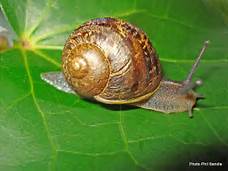Right and Left Handed Snails?
(PhysOrg.com)
-- Snail shells can spiral to the left (sinistral) or to the right (dextral), determined
by a single gene. The effect of this difference has produced a separate
distinct species. The most common snails are dextral, and sinistral are rare.
This is a common right spiraled dextral snail
This is a rare left spiraled sinistral snailThe majority of snails are dextral
Mating
between sinistral and dextral snails is
almost impossible because their genitals are on opposite sides of their body. The
mating of the large Satsuma snails, for example, takes place face-to-face. All
snails have both male and female reproductive organs, but when both snails are
dextral or both are sinistral, everything lines up nicely. When one is dextral
and the other sinistral the genitals line up male-male and female-female.
It has been
determined that dextral snails came from sinistral snails, caused by a single recessive
gene replacement. Dextral snails are far more common than sinistral snails, and
therefore have more mating opportunities, so why does the sinistral survive?
Survival of the fittest would surly cause them to become extinct. This and the
difficulty in mating means sinistral snails should become extinct unless
sinistrality has some advantage. Scientists in Japan and Taiwan have discovered
the advantage may be a resistance to snake predation.
Southeast
Asian snakes of the pareatidae family — oriental slug-eating snakes —
specialize in eating slugs and snails, and because the majority of snails are
dextral with the shells on the right side, the snakes attack from the left,
grabbing the shell with its upper jaw and sticking its lower jaw into the gap.
The snakes have also evolved (Notice the assumed evolution bias. This is simply
a genetic variation or loss of information. It produces an exact mirror image,
and is not evolution into something else.) asymmetrical mouth parts with more
fangs on one side than the other to help them eat the dextral snails. (No, this
is design when it was created) These changes (Excuse me there are no changes,
this snake has always had these features. You show no evidence because there
isn’t any), however, make it difficult for them to eat sinistral snails,
especially as the snakes continue to attack from the left. (Then how come the
snake hasn’t evolved this?)
Researchers
led by Dr. Masaki Hoso of Tohoku University looked at the distribution of
Satsuma snails and the slug-eating snake species in Japan, and discovered that
in areas where the snakes are found, there are more sinistral Satsuma snails than
elsewhere.
The team had
predicted (Now this is science) that sinistral snails with larger shells such
as Satsuma snails should also survive better than Bradybaena similaris snails,
which have smaller shells, because they were more difficult for the snakes to
handle.
To test
their hypotheses the researchers kept sinistral and dextral snails of both
species and exposed them to predation from slug-eating snakes. The results were that none of
the dextral Satsuma snails escaped being eaten, but 87.5 percent of the
sinistral snails survived. In the smaller snails the survival rate for
sinistral snails was smaller but they had a huge advantage over dextral snails.
The results
led Dr. Hoso to predict that at some point the protection from predation would
outweigh the mating difficulties and the chirality, or direction in which the
shell coils, would become fixed in the opposite direction and the two groups
become separate species and evolve their separate ways (Wrong, both snails have
a gene that can make them either). To test this idea, the researchers sequenced
the DNA of all Satsuma snail species found in Japan and built a family tree to
show their relationships. The tree demonstrated clearly that sinistral species
have evolved (Micro-evolution or adaptation, not macro-evolution) from dextral
snails at least six times, and that in at least four of these occasions the
reversal was due to a change in a single gene.
(This falsifies survival of the fittest. According to scientists who believe in creation variations in genetic of individuals causes some to survive under any circumstances. This is not a cause of extinction. And evidence indicates most extinctions were caused by major worldwide cataclysms)
The reversal
results in a massive advantage, because virtually overnight a group of snails
is adapted to survive predation and is separated from other members of the
species and can (Vary within the same kind!) evolve separately. Hoso said these
events represent the “hopeful monster,” (Wrong again. The hopeful monster was
when a bird hatched from a reptile egg. This can only happen by genetic engineering
at Area 51) an idea put forward by geneticist Richard Goldschmidt (Proven wrong
a long time ago. Now used as evolution propaganda), who said small genetic
changes could result in large evolutionary change (Wrong, small changes do not
change the kind of organism and it always reverts back to the original kind
like Darwin’s Finches).
When you such
interesting discoveries they always insert their atheistic unscientific
materialistic interpretation and miss the greatest truth. What is the meaning
of all this? That a naturalistic process created amazing things? No, that there
was a designer! And that all this was engineered to help the snails and snakes
to survive in an evil world. The more you study design in nature the more improbable
evolution becomes which supports the information given in the Bible.
Romans 1:20
For the invisible things of him from the
creation of the world are clearly seen, being understood by the things that are
made, even his eternal power and Godhead; so that they are
without excuse.





Comments
Post a Comment